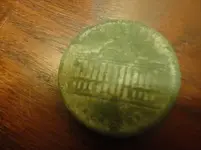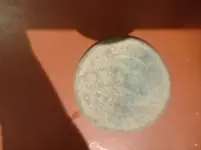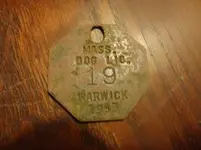Yes it's an HTT. I think it probably says Merchants Exchange on the front and New York Joint Stock Exchange Company on the back outer rim, with No 6 Tontine building Wall st on the inside of that.
It is listed as New York. New York. Merchants Exchange. (1837). HT-294, Low-98. Copper. Rarity-1.
Both the Merchants Exchange and the Tontine Building are mentioned on hard times tokens HT-291 through HT-294.
Behind these names is one of the most unusual business arrangements America has ever seen. AS a "tontine" was a legal device whereby survivors split an inheritance at some point specified, adn those unfortunate enough to die earlier get nothing.
The Tontine Coffee House building, at the corner of Wall and Wate Streets in New Tork, was commenced in 1792 and completed in1794. It and a large amount of surrounding land were owned by and association of 203 cirty merhcnats and other prosperous persons, who has subscribed at $200 per share. Thus the initial capital was $40,600.
The Tontine scheme was to divided equally when the original 203 holders had been reduced by death to just seven! Share purchasers often named their children, not themselves, as the share owners. Meanwhile, shareholders shared the income of the entity, which owned a good portion of what was then the 2nd Ward (bounded by Pine St., Nassau St., East River, and Gold and Geogre Sts.). The first five trustees for the 203 shareholders, who were to meet every year in the Tontine Coffee House, were John Broome, Gulian Verplanck the Elder, John Delafield, William Laight and John Watts.
The Tontine was also a hotel, and rented street shop space to certain merchants, such as John R. D. Huggins, the famed hairdresser who kept his shop ther 1794-1800. The Tontine's charter was signed Nov. 4, 1794.
The largest room in the Tontine housed the Merchants Exchange 1794-1825, but it soon outgrew its quarters, with bargaining being conducted in the bar, etc. A supposedly fireproof Merchants Exchange building was erected 1827 on Wall Street, but it was destroyed in the Great Fire of 1835.
From 1797-1812 the Tontine Coffe House served from 11AM to 1PM punch, lemonade, crackers, cheese, and codfish at their splendid bar. The merchants called this "lunch." The Gulian C. Verplanck of HT 30 (born 1786) and William Bayard (born 1791) were original shareholders as children. The Tontine Coffee House was renamed the Tontine Building in 1843.
The Tontine scheme was sort of "Russian roulette". When the 203 were reduced to 7, the survivors were to divvy up the loot. By 1862, 70 years after the plot was hatched, it was found that a family named De Peyster had bought up some two-thirds of the outstanding shares.
To clean- you should only use warm, soapy water and a microfiber cloth to remove surface dirt. Elbow grease is not required, because even the slightest bit of friction between the fibers in the rag and the copper can scratch away surface patina, which will allow oxygenation to occur at deeper levels. Do not use regular wash cloths, brushes or paper towels, as they are too abrasive to gently remove surface grit. That's about all you can do short of soaking in olive oil for weeks or even months.






